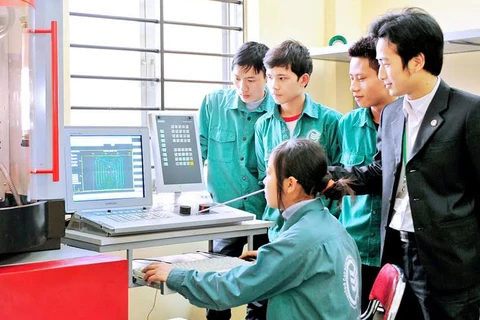 Farmers harvesting oranges on a farm in northern Tuyên Quang Province. Việt Nam needs to improve labour productivity to boost economic growth towards sustainablity and efficiency. (Photo: VNA)
Farmers harvesting oranges on a farm in northern Tuyên Quang Province. Việt Nam needs to improve labour productivity to boost economic growth towards sustainablity and efficiency. (Photo: VNA)Hanoi (VNA) – Improving labour productivity is now critical for Vietnam to boost gross domestic product (GDP) per capita to become an industrialised and upper-middle income nation in the next two decades.
Minister of Planning and Investment Bui Quang Vinh said that with an ambitious goal of achieving a GDP growth rate of 7 percent to 8 percent set in the Socio-economic Development Strategy in the 2011-2020 period, the Southeast Asian country must shift its economic growth model from extensive to intensive, and the core issue in the transition process was improving labour productivity.
According to Nguyen Quoc Viet from the Vietnam National University’s University of Economics and Business, limitations of an extensive economic growth model which are based on the expansion of the quantity of inputs such as capital, labour, and resources, were hindering the implementation of economic stimulus policies.
Viet wrote in a story published on bnews.com that the capital now contributed around 60 percent to GDP growth while total factor productivity (TFP) contributed about 25 percent, compared to the rate of 50 percent in developed economies.
An analysis by the General Statistics Office (GSO) said that labour productivity of Vietnam remained lower than other countries in the region and was uneven between industries. The statistics office said that the gaps between labour productivity based on purchasing power parity in 2005 of Vietnam were widened during 1994 to 2013 period with Asean+4 countries, including Singapore, Malaysia, Thailand and Indonesia by between 50 percent, 43 percent, 17 percent and 7 percent, respectively.
The Statistics office said that this was due to the slow economic growth model transition, with labour in the farming sector accounting for a large percentage with low productivity.
According to Nguyen Thi Huong, Director of GSO’s Agricultural Statistics, many labour-intensive industries such as the farming sector had low added value, resulting in low productivity.
The 12th National Party Congress’s documents also pointed out problems of the Vietnamese economy. There was heavy dependence on investments for growth, low-skilled labour, modest application of science and technology, and slow improvement in productivity.
Improving labour productivity and growth quality were the two most important issues for Vietnam with regard to macroeconomic stability, economic efficiency and sustainable development, experts said.
“Increasing labour productivity is the only way to reach a GDP per capita between 15,000 USD and 18,000 USD by 2035,” Vinh said.
The TFP of Vietnam must be increased to around 35 percent to enable the country to fulfil its goals by 2020.
An economic expert said that one solution to enhancing labour productivity was shifting to sectors with high content of science and technology and high added value from sectors such as support, IT and processing.
Developing the private economic sector was also important to drive the development of a skilled labour market and improve management capacity, which would contribute to boosting productivity.
The report "Vietnam 2035: Toward Prosperity, Creativity, Equity and Democracy" last month in co-ordination of the Vietnamese government and the World Bank said that improving productivity was essential for the country to reach upper-middle income status by 2035.
Christine Largarde, Managing Director of the International Monetary Fund, at a meeting with students of the National Economics University last week urged Vietnam to boost labour productivity, adding that local SOEs and private companies currently have very low productivity, which is only about one-fifth of that of foreign-invested firms.-VNA























